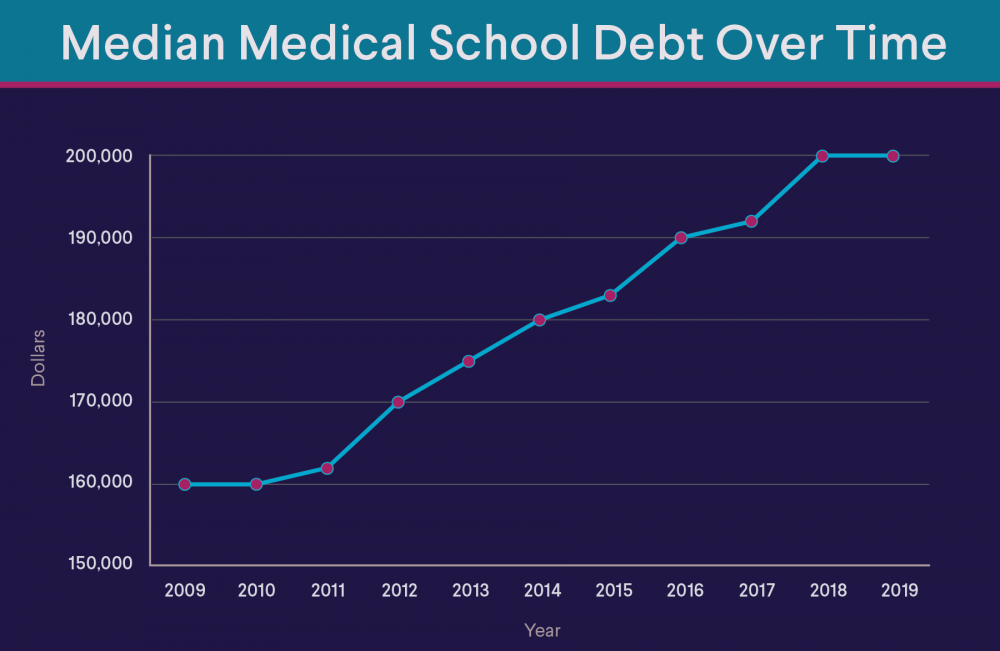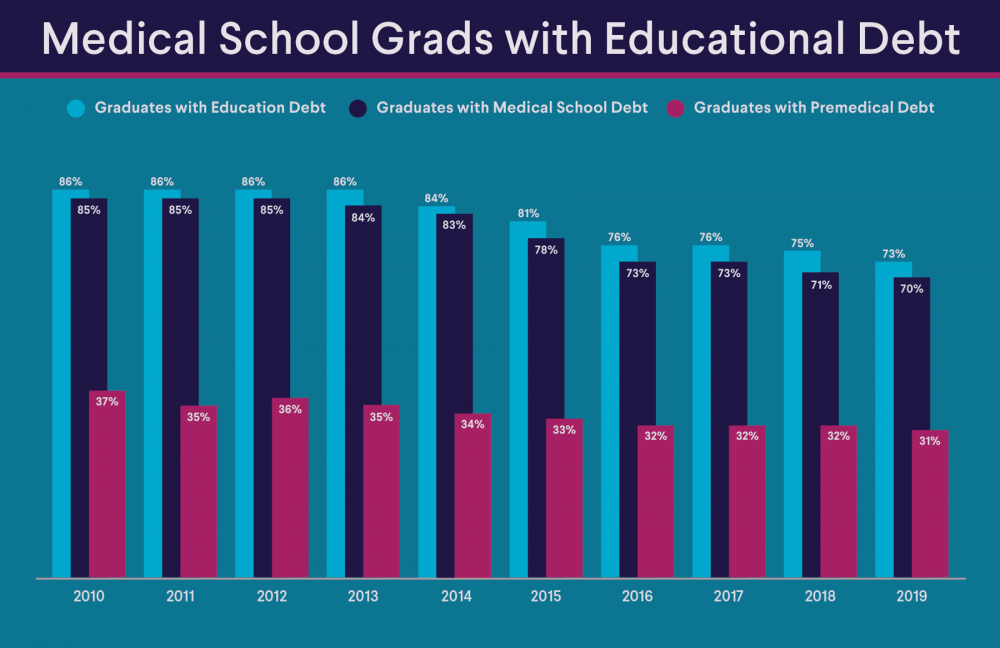According to the Association of American Medical Colleges (AAMC), the average medical school debt for students who graduated in 2022 was $205,037.
While many med school students eventually may earn six figures or more, they also can expect to graduate with student debt that averages close to a quarter of a million dollars.
And that’s just what these graduates owe for their medical school education. Researchers at EducationData.org found that 43% of indebted medical school graduates also have premedical education debt to pay for.
Because of the high cost of the average debt of a medical student, it’s crucial for aspiring and current medical school students, and graduates, to understand their debt repayment options.
Medical School Debt Statistics
Here’s a snapshot of what the average med school debt can look like for graduates, based on a roundup of the most recent statistics available:
• According to a 2022 report by EducationData.org, medical school graduates had, on average, $250,990 in total education debt (premed and medical school). Compare that with the average educational debt for the class of 1999-2000: $87,020.
• When the AAMC looked at members of the class of 2020 who took out educational loans, it found that:
◦ 5.4% borrowed $1 to $49,999 for premed studies and medical school
◦ 6.1% borrowed $50,000 to $99,999
◦ 8.2% borrowed $100,000 to $149,999
◦ 13.7% borrowed $150,000 to $199,999
◦ 25.1% borrowed $200,000 to $299,999
◦ 11.2% borrowed $300,000 to $399,999
◦ 2.9% borrowed $400,000 to $499,999
• While the cost of medical school grew 2.5%, the annual growth rate of medical school debt is 12.4%, as calculated by EducationData.

Source: Association of American Medical Colleges
What Does This Mean for Borrowers?
It’s important to note that, when it comes to borrowing for medical school, loan interest rates offered by the federal government, along with the terms and conditions, might be different from borrowing as an undergrad. This is one of the basics of student loans that it’s helpful to understand when it comes to the average medical school debt.
Some med students may benefit from scholarships and loan forgiveness programs that could cut their costs substantially. But many will end up making loan payments for years—or even decades.
So what does the average medical student debt look like? According to the number crunchers at EducationData, the average doctor will ultimately pay from $135,000 to $440,000 for his or her educational loans, with interest factored in.

Source: Association of American Medical Colleges
Medical School Loan Options
Types of federal student loans available to medical students to help with the average med school debt include Direct Unsubsidized Loans, with a limit of $20,500 each year.
Rates for this type of loan are currently lower than for the other type of federal student loan available to those going to medical school, Direct PLUS loans. The current rate for Direct Unsubsidized Loans is 6.54%, while Direct PLUS loans have an interest rate of 7.54% through July 1, 2023.
There isn’t a financial need requirement for either type of federal student loan, so many medical students qualify for both. With Direct Unsubsidized Loans, there is no credit check, but there is a credit check for PLUS loans.
Medical students also can apply for private student loans to help cover their average medical student debt. Generally, borrowers need a solid credit history for private student loans, among other financial factors that will vary by lender. Private lenders offer different rates, terms, and overall loan programs.
Federal loans come with many student protections and benefits that private loans don’t, such as the Public Service Loan Forgiveness program and income-driven repayment.
Medical students also may choose to defer federal student loans during their residency, which isn’t typically an option with private student loans.
Recommended: Private Student Loans Guide
How to Deal With Debt
There are several strategies that graduates grappling with the average medical student debt may want to consider.
Deferment
If you’ve ever borrowed money—for school or otherwise—you know that two critical factors can influence how much the loan will cost overall.
• The interest rate you’re paying
• How long you take to repay the loan or loans.
The repayment timeline is often extended when medical residents make partial monthly loan payments or no payments at all. Putting off payments may seem like a good idea during a stressful time, but delaying can be costly.
Most federal student loans, when deferred, continue to accrue interest. The problem those in medical fields can face is debt accumulation during their residency, which can last anywhere from three to seven years.
Even while making a modest income—in 2022, the average resident earned $64,200, according to Medscape—the debt would grow considerably.
Part or all of your unpaid interest might currently be capitalized when you complete your residency. This means the accrued interest is added to the principal of the loan, and that new value is then used to calculate the amount of interest owed. However, thanks to new regulations set to take effect in July 2023, interest capitalization will be eliminated on most federal student loans, saving borrowers money.
If you decide to put your loans in deferment or forbearance, making interest-only payments and putting that money toward student loans can reduce the amount of interest that could be added to the loan.
Income-Driven Repayment
An income-driven repayment plan is an option for medical residents who can’t afford full payments. The four plans limit payments to a percentage of borrowers’ income, extend the repayment period to 20 or 25 years, and promise forgiveness of any remaining balance.
In general, borrowers qualify for lower loan payments if their total student loan debt exceeds their annual income. Payments are based on discretionary income, family size, and state.
Refinancing Loans
Refinancing medical school loans to help cover the average medical student debt is an option during residency, after residency, or both.
Refinancing student loans with a private lender might help save you money if you can get a lower interest rate than the rates of your current student loans.
Student loan refinancing means paying off one or more of your existing federal and private student loans with one new loan. An advantage of refinancing student loans is that you’ll only have one monthly payment to make.
If you refinance your student loans and get a better rate, you could choose a term that allows you to pay off the loan more quickly if you’re able to shoulder the payments, which should save you in interest.
However, refinancing isn’t a good fit for those who wish to take advantage of federal programs and protections. Refinancing federal loans means you no longer have access to these benefits.
Recommended: Student Loan Refinancing Calculator
Consolidating Loans
The federal government offers Direct Consolidation Loans, through which multiple eligible federal student loans are combined into one. The interest rate on the new loan is the average of the original loans’ interest rates, rounded up to the nearest one-eighth of a percentage point.
If your payment goes down, it’s likely because the term has been extended from the standard 10-year repayment to up to 30 years. Although you may pay less each month, you’ll also be paying more in interest over the life of your loan.
Schools With the Highest Student Debt
When it comes to student debt, all medical programs are not equal. According to U.S. News and World Report’s “Best Grad School” rankings, the range can be extensive. Out of 122 medical schools listed, the three that left grads with the most debt in 2022 were:
• Nova Southeastern University Patel College of Osteopathic Medicine (Patel) in Fort Lauderdale, Florida: $322,067
• Western University of Health Sciences in Pomona, California: $281,104
• West Virginia School of Osteopathic Medicine in Lewisburg, West Virginia: $268,416
On the other end of the spectrum, the school that graduated students with the least amount of debt in 2022 was New York University in New York, New York, with about $85,000.
Public vs. Private Medical School
The cost of attending a private medical school is typically higher than a public school.
According to the AAMC, these were the median costs of tuition, fees, and health insurance for first-year medical students during the 2022-2023 school year.
• Private school, in-state resident: $67,294
• Private school, nonresident: $67,855
• Public school, in-state resident: $41,095
• Public school, nonresident: $65,744
According to EducationData, however, the average public medical school graduate leaves school owing a higher percentage of the cost of attendance (79.9%) than the average private school medical school graduate (65.1%).
The Takeaway
There’s no doubt that studying medicine can lead to a lucrative career, but the route can be daunting, in every way. When the average debt of a medical student tops $250,000, some aspiring and newly minted doctors look for a remedy, stat.
If you’re leaning toward refinancing, SoFi’s student loan refinancing offers a fixed or variable interest rate, no fees, and a simple online application. SoFi also has a program specifically for medical residents. Potential borrowers might benefit from a low rate or low monthly payments during residency.
SoFi Student Loan Refinance
If you are a federal student loan borrower, you should consider all of your repayment opportunities including the opportunity to refinance your student loan debt at a lower APR or to extend your term to achieve a lower monthly payment. Please note that once you refinance federal student loans you will no longer be eligible for current or future flexible payment options available to federal loan borrowers, including but not limited to income-based repayment plans or extended repayment plans.
Third-Party Brand Mentions: No brands, products, or companies mentioned are affiliated with SoFi, nor do they endorse or sponsor this article. Third-party trademarks referenced herein are property of their respective owners.
Financial Tips & Strategies: The tips provided on this website are of a general nature and do not take into account your specific objectives, financial situation, and needs. You should always consider their appropriateness given your own circumstances.
SoFi Loan Products
SoFi loans are originated by SoFi Bank, N.A., NMLS #696891 (Member FDIC). For additional product-specific legal and licensing information, see SoFi.com/legal. Equal Housing Lender.
SOSL0523019
